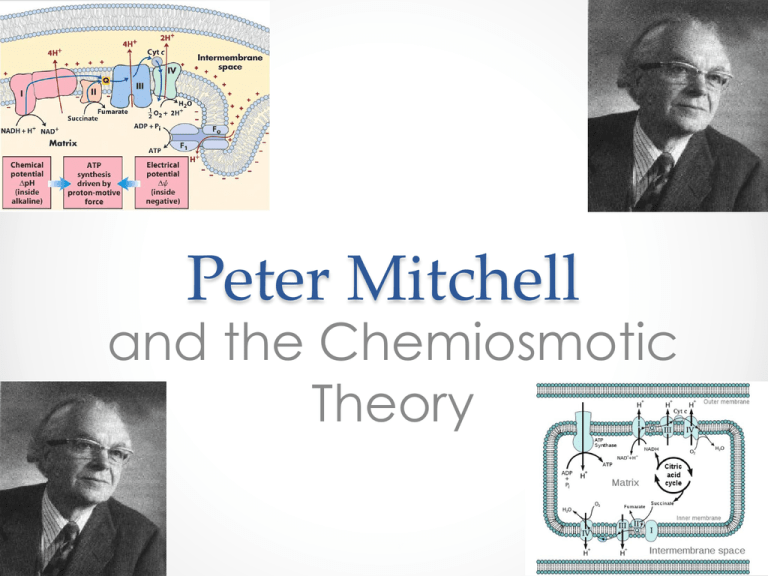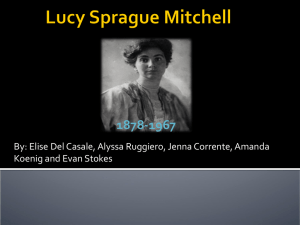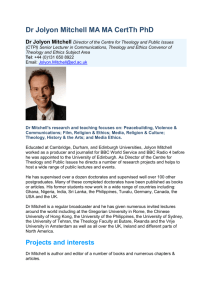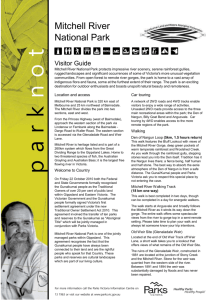(1) Peter Mitchell and the Chemiosmotic Theory
advertisement

Peter Mitchell and the Chemiosmotic Theory Who is Peter Mitchell? • Was born 29th September, 1920 and died 10th April 1992. • Was a British biochemist and a Fellow of the Royal Society. • He went to Queen's College, Taunton, and Jesus College, Cambridge where he studied the Natural Sciences and specialized in biochemistry. • In 1978 he won the Nobel Prize in Chemistry “for his contribution to the understanding of biological energy transfer through the formulation of the chemiosmotic theory.” What We Know So Far… • In 1945, Albert Lehninger established the existence of a link between the Krebs cycle and the catabolism of fatty acids In he cell. • In 1949, Morris Friedkin, together with his PhD supervisor, Albert Lehninger , showed the existence of a connection between different metabolic pathways for coenzyme NADH to oxygen as a source of energy in oxidative phosphorylation. Introduction • After the Krebs cycle was found, biochemists began to used Hans Krebs’ method of finding the steps of the Krebs cycle to find the steps to make ATP. • In the late 1940s, scientists who studied membrane transport were separate into two distinct groups: those who studied the membrane and those who studied proteins, enzymes, and reactions they catalyzed. • As a biochemistry graduate student at Cambridge University in that time period, Mitchell began to study membranes Mitchell thought of membrane transport as both a physical phenomenon and a chemical reaction using energy where the chemical reaction changed reactants on one side of the membrane to products on the other side of the membrane. The Experimental Process • Experimented on bacteria and studied how they transported various compounds across their membranes. • Concluded that chemical reactions occurred in 3-D spaces. • Began to see energy-and-membrane transport process in reverse. • A grad student found that the transport of a certain sugar in bacteria correlated with the movement of a H+ ion. • Shifted his efforts from working on bacteria to working on eukaryotic mitochondria as well as the membranes of plant cell chloroplasts. The Experimental Process (Cont’d.) • In 1965, Mitchell was asked to present his chemiosmotic ideas at a conference. • Learned how to measure proton concentration (pH) in the solution outside the mitochondria. • Significant Issue: how electrons could carry protons across the membrane while moving down energy levels. • He continually revised and changed his ideas. He sought advice and peer review. The Breakthrough • Cornell University Student André Jagendorf a graduate student had measured the proton changes due to electron transport in chloroplasts. In order to make sure this wasn’t a coincidence, they set up and experiment where an imbalance of protons was artificially created in order to view the possible effects. • First they incubated chloroplasts in acid baths and allowed protons to saturate the solution both inside and outside the chloroplast membrane. Then, they put the chloroplasts in a solution with a lower concentration of protons, which created an imbalance of protons across the chloroplast membrane, and thus, produced ATP. • This experiment was conducted in the dark so that the chloroplasts wouldn’t use light energy. It was concluded that the induced proton imbalance must have made the ATP, mimicking the real life situation in chloroplasts when light is present. The Independent and Dependent Variables Independent Variable The acid solution Dependent Variable The ATP (whether or not it was produced) In The End… • Peter Mitchell was the sole recipient of the Nobel Prize for Chemistry in 1978, in recognition of “his predominant contribution towards establishing the validity of the chemiosmotic hypothesis, and ipso facto, the long struggle to convince an initially hostile establishment.” • The chemiosmotic theory is now generally accepted as a fundamental principle in biogenetics and now provides a rational basis on future work on the details of oxidative phosphorylation. References • • • • • Allchin, Douglas. "Peter Mitchell & How Cells Make ATP."http://www1.umn.edu/ships/db/mitchell.pdf. University of Minnesota - Twin Cities, n.d. Web. 24 Oct 2011. <http://www1.umn.edu/ships/db/mitchell.pdf>. Crofts, Anthony. "Peter Mitchell and The Chemiosmotic Hypothesis."Life Sciences -University of Illinois at Urbana-Champaign. University of Illinois at Urbana-Champaign, 1996. Web. 23 Oct 2011. http://www.life.illinois.edu/crofts/bioph354/mitchell.html "Functions of NAD (Nicotinamide adenine dinucleotide) ."Nangluongsinhhoc. Blogger, 2011. Web. 23 Oct 2011. <http://nangluongsinhhoc2011.blogspot.com/2011/04/functions-of-nadnicotinamide-adenine.html>. "Press Release: The 1978 Nobel Prize in Chemistry". Nobelprize.org. 24 Oct 2011. http://www.nobelprize.org/nobel_prizes/chemistry/laureates/1978/press.h tml Wikipedia, . "Peter D. Mitchell."Wikipedia. Wikimedia Foundation, Inc., 24th September 2011. Web. 23 Oct 2011. <http://en.wikipedia.org/wiki/Peter_D._Mitchell>.











